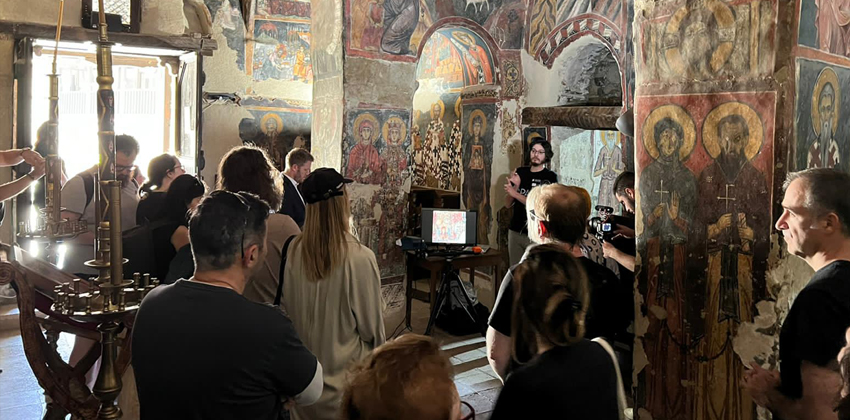On the occasion of the International Day of Monuments and Sites and in collaboration with the Department of Antiquities, the Bishopric of Morphou, the village of Kalopanagiotis and the British High Commission, CyI’s Andreas Pittas Art Characterization Laboratories (APAC Labs) organized a day-long program on the 18th of April at the UNESCO world heritage site of the Monastery of St. John Lampadistis. The event offered guided tours and focused presentations on the interdisciplinary research work pursued at the site by APAC Labs / STARC specialists and other experts.
Greetings from the Director of Antiquities Dr. Marina Solomidou-Ieronymidou and the Metropolitan of Morphou Neophytos welcomed visitors to the event which was briefly addressed by the mayor of the village of Kalopanagiotis Mr. Lambrou, British Deputy High Commissioner Ben Rawlings and STARC Director Dr. Michel Menu. Throughout the monastic complex, specialists were on hand to provide spotlight presentations on the various studies APAC Labs has performed at the site. Assoc. Professor Nikolas Bakirtzis, introduced visitors to the history, the art and architecture of the Byzantine monastery. Mia Gaia Trentin and Stelios Irakleous provided key insights into the studies of historic graffiti and Karamanli pilgrims at the monastery. Raphael Moreau, CyI PhD candidate, presented preliminary results of an ongoing multi-sensored analysis of wall paintings in the monastic church. Another PhD candidate, Mehmetcan Soyluoglu, introduced visitors to dendrochronological research and sampling of the site’s wooden heritage. Assoc. Professor Sorin Hermon and PhD candidate Luciarita Nunziata offered a look at the processes for capturing 3D data of the site and documenting environmental challenges and threats. Finally, PhD student Nicolette Vollero Levy gave a tour of the Monastery’s icon museum, highlighting new information about icons revealed by APAC Labs’ technical analysis. Andriana Nikolaidou, Rahaf Orabi, Antonia Agapiou, Soodabeh Sajadi, Valentina Vassalo and Anastasia Tsanga contributed to the preparation and the organization of the successful event which was well attended by numerous groups of local and international visitors.
The ''Tracing History at the Monastery of St. John Lampadistis'' event was part of the broader program of APAC Labs events celebrating three years of operation. Thanks to the generous support of Dr. Andreas Pittas, APAC Labs / STARC researchers have been developing task-specific service protocols related to material characterization and data integration, address issues of provenance, and assess the state of preservation of works of art, archaeological objects and monuments. The organization of the APAC day at Kalopanagiotis allowed the opportunity to share exciting research results and to promote the meaningful use of science and technology in the ways we study and understand the past and the precious cultural heritage of Cyprus.
